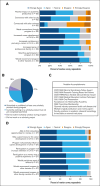Evaluating the impact of a year-long external mentorship pilot program in classical hematology
- PMID: 39087874
- PMCID: PMC11416643
- DOI: 10.1182/bloodadvances.2024013218
Evaluating the impact of a year-long external mentorship pilot program in classical hematology
Abstract
Effective mentorship is a pivotal factor in shaping the career trajectory of trainees interested in classical hematology (CH), which is of critical importance due to the anticipated decline in the CH workforce. However, there is a lack of mentorship opportunities within CH compared with medical oncology. To address this need, a year-long external mentorship program was implemented through the American Society of Hematology Medical Educators Institute. Thirty-five hematology/oncology fellows interested in CH and 34 academically productive faculty mentors from different institutions across North America were paired in a meticulous process that considered individual interests, experiences, and background. Pairs were expected to meet virtually once a month. Participation in a scholarly project was optional. A mixed-methods sequential explanatory design was used to evaluate the program using mentee and mentor surveys, a mentee interview, and a mentee focus group. Thirty-three mentee-mentor pairs (94.2%) completed the program. Sixty-three percent of mentee respondents worked on a scholarly project with their mentor; several mentees earned publications, grants, and awards. Mentee perception that their assigned mentor was a good match was associated with a perceived positive impact on confidence (P = .0423), career development (P = .0423), and professional identity (P = .0302). Furthermore, 23 mentees (66%) accepted CH faculty positions after fellowship. All mentor respondents believed that this program would increase retention in CH. This mentorship program demonstrates a productive, beneficial way of connecting mentees and mentors from different institutions to improve the careers of CH trainees, with the ultimate goal of increasing retention in CH.
© 2024 by The American Society of Hematology. Licensed under Creative Commons Attribution-NonCommercial-NoDerivatives 4.0 International (CC BY-NC-ND 4.0), permitting only noncommercial, nonderivative use with attribution. All other rights reserved.
Conflict of interest statement
Conflict-of-interest disclosure: N.T.C. is a consultant for Takeda; participates in advisory boards for Takeda, Genentech, Sanofi, and Medzown; has equity in Medzown; and receives honoraria/travel support from Octapharma. A.v.D. has received honoraria for participating in scientific advisory board panels, consulting, and speaking engagements from BioMarin, Regeneron, Pfizer, Bioverativ/Sanofi, CSL Behring, Novo Nordisk, Precision Medicine, Sparx Therapeutics, Takeda, Genentech, and uniQure; and is a cofounder and member of the board of directors of Hematherix LLC, a biotech company that is developing superFVa therapy for bleeding complications. R.L.Z. is a consultant and stockholder for Triveni Bio. The remaining authors declare no competing financial interests.
Figures



References
-
- Bauer KA. Current challenges in the management of hemophilia. Am J Manag Care. 2015;21(suppl 6):S112–S122. - PubMed

